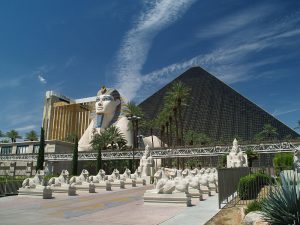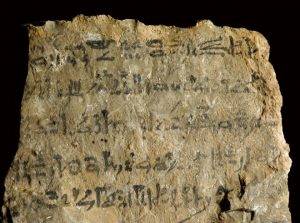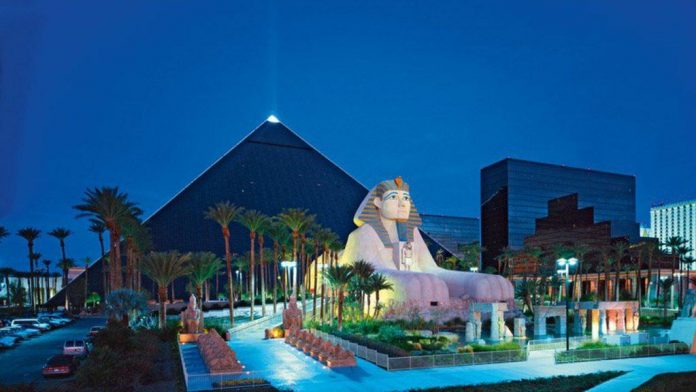By day, it’s a giant glass gambling pyramid with a huge sphinx guarding its entrance. At night, the most powerful beam of light on Earth shoots skyward from its apex, piercing the evening sky. Modeled after the Great Pyramids of Egypt, the Luxor Las Vegas is a mixture of myth and marvel – and not without its mysteries and tall tales.

Impossible Oasis
 Hunter S. Thompson was speeding through the desert in the Great Red Shark convertible on his way to Vegas when the drugs took hold — and screeching bats descended from the sky. His Samoan attorney was pouring beer on his bare chest to facilitate the tanning process. Thus began the surreal and substance-soaked epic journey that would become the gonzo journalism gem Fear and Loathing in Las Vegas, Thompson’s masterpiece.
Hunter S. Thompson was speeding through the desert in the Great Red Shark convertible on his way to Vegas when the drugs took hold — and screeching bats descended from the sky. His Samoan attorney was pouring beer on his bare chest to facilitate the tanning process. Thus began the surreal and substance-soaked epic journey that would become the gonzo journalism gem Fear and Loathing in Las Vegas, Thompson’s masterpiece.
Descending into the Las Vegas desert from the sky is also a surreal experience. Your plane soars over miles of desolate wasteland pockmarked with blanched sandscapes dotted with red-hued mountains. But not a bat in sight.
Las Vegas is an impossible oasis, a testament to the determination and decadence of humankind.
And then you see it: rising up from the desert below is something out of a psychedelic dream. An onyx-black pyramid juts out of the sand, guarded by a giant sphinx. One long strip of road is strewn with replicas of world monuments, from the Egyptian pyramids to the Eiffel Tower, and everything in between. Las Vegas is an impossible oasis, a testament to the determination and decadence of humankind.
Billions of dollars built resorts in the Nevada desert for the sole purpose of gambling, with all the trimmings. But there may be a hidden curse which came along with the ancient Egyptian theme.
Luxor’s History
 The Luxor was built in 1993 by Circus Circus Enterprises. The same company that gave us the giant canopy of flying trapeze artists under its casino big top gave us a new icon on the Las Vegas Strip. Named after the Egyptian city of Luxor and modeled after the Great Pyramid of Giza, the Luxor Vegas pyramid is three-quarters the size of the original, and stands 30 stories high.
The Luxor was built in 1993 by Circus Circus Enterprises. The same company that gave us the giant canopy of flying trapeze artists under its casino big top gave us a new icon on the Las Vegas Strip. Named after the Egyptian city of Luxor and modeled after the Great Pyramid of Giza, the Luxor Vegas pyramid is three-quarters the size of the original, and stands 30 stories high.
The ‘family friendly’ era of Vegas aimed to remold Sin City into something the whole family could enjoy – guilt free. The resort features radically-sloping walls that make up the largest atrium in the world (29 million cubic feet), housing the casino, hotel, restaurants, IMAX Theater, and show venues. Neon hieroglyphics adorn the walls of the atrium, and thousands of slots below them spin up their own sacred symbols.
The first incarnation of the Luxor was finished in only 18 months, and its diagonally-traveling elevator – called the inclinator – is an engineering marvel. The resort has had its share of upgrades, especially after some construction deaths, faulty inclinator incidents, and bizarre setbacks. At one point, the building started sinking into a soft spot in the desert floor, something which had never happened anywhere else on the Las Vegas Strip.
But the strange incidents and bizarre situations would continue over the years to come, leading some to believe the Luxor was cursed.
Ancient Egyptian Curse?
 The theme’s the thing wherein they capture the crowds in Vegas. Back in the early days of the Las Vegas Strip, casinos were little more than overblown saloons with Old West themes. After the megaresort casino explosion in the 80s, no theme could be gaudy or tacky enough to draw the crowds. Fake volcanos rumble and spew red light, gondoliers glide through replica Venetian canals, and every decade they blow up a few casinos and start over.
The theme’s the thing wherein they capture the crowds in Vegas. Back in the early days of the Las Vegas Strip, casinos were little more than overblown saloons with Old West themes. After the megaresort casino explosion in the 80s, no theme could be gaudy or tacky enough to draw the crowds. Fake volcanos rumble and spew red light, gondoliers glide through replica Venetian canals, and every decade they blow up a few casinos and start over.
Designers planned the Luxor as a cartoonish replica of ancient Egypt, with a playground feel to attract the whole family, but luxurious enough to draw a few high rollers as well. At one point, Luxor had a replica of King Tut’s tomb that was authorized by the Egyptian Ministry of Antiquities. But with all this attention to detail, could the builders possibly have inherited an ancient Egyptian curse? Years of bizarre tragedies in the Luxor whisper rumors of a curse.
During the rush to finish the Luxor on schedule, the builders ran into a few hitches along the way. Local sources say seven workers died during the construction process, due to the treacherous nature of building at 39-degree angles.
In 1996, a woman jumped from the 26th story of the Luxor hotel and died. She wasn’t carrying ID on her person and was listed as a Jane Doe. The reason for her death was never established, and locals like to create urban legends around her death. A few years later, a man fell to his death from the 10th floor. The reasons for his death were also listed as mysterious.
Some superstitious souls say that the Luxor is cursed because it was modeled after a tomb. Some of these sensitive souls wouldn’t even step foot inside the Luxor when they found out it was built over a possible burial site containing victims of the mob. And then there’s the theory that the shape of the giant black pyramid attracts dark energy.
Bombs, Fights, Falls, and Plagues
In 2007 in the Luxor parking garage, a casino employee noticed a coffee cup left on top of his car. The 24-year-old food court employee went to remove the cup – and it exploded, killing the man. Later, two men were arrested and convicted of making and placing the coffee cup bomb. They did not know the victim, and there was no motive found for the bizarre bombing.
And the hits just kept on coming, especially when a college football player got into a fatal fight with an MMA fighter. In a Luxor suite in 2010, a UNLV college football player named DeMario Reynolds got into a drunken brawl with an MMA fighter named Jason Sindelar, who was arguing and fighting with his girlfriend at a party in the suite.
Reynolds restrained his friend Sindelar when he became drunk and abusive, and asked him to leave. But Sindelar returned to the party later, and surprised Reynolds by knocking him to the floor and beating him nearly to death. After the pair were separated, Reynolds was taken to the hospital, where he died from his injuries.
In 2012, two men got into a fight near an elevator in the first floor lobby of the Luxor. One man pushed the other against the door to an inclinator, and the door suddenly opened. However, there was no elevator car present, and the man fell down the empty elevator shaft to the basement level. He was taken to the hospital in critical condition, but there were no further updates on his condition. Some say he died.
Every curse needs a plague of some sort, and in 2012, the Luxor got one. When three hotel guests suddenly feel ill from unknown causes, authorities tested the Luxor’s water – and found the Legionella bacteria, which causes Legionnaires’ disease. By the time the hotel responded and killed the water-dwelling bacteria, two of the three hotel guests had died from the infection.
Local Vegas ‘ghost tour’ websites would have you believe that all of these dead people can be seen shuffling through the hexed halls of the Luxor to this day. Whether or not you believe in ghosts, ancient Egyptian curses, or rushed construction in Sin City, the Luxor still cuts through the black night with its Sky Beam burning at 42.3 billion candela.
And the visitors come from hundreds and thousands of miles away, like moths to the flame.
Disclaimer: All images are copyright to their respective owners and are used by USA Online Casino for informational purposes only.










